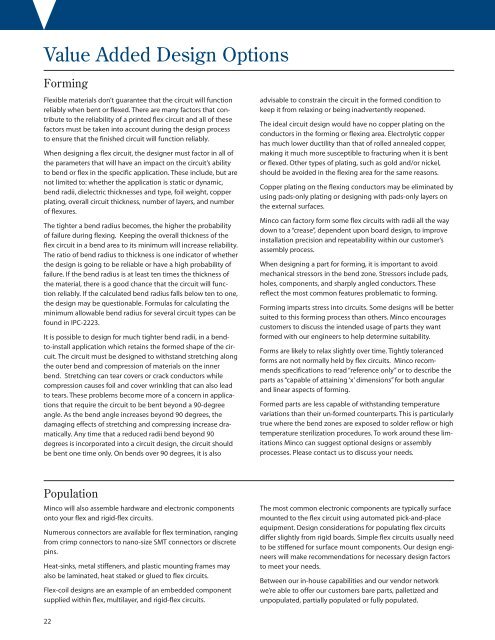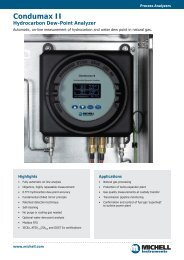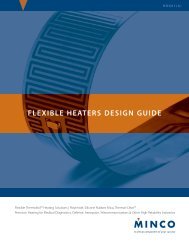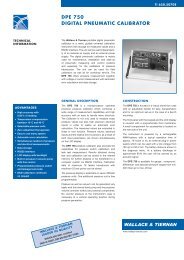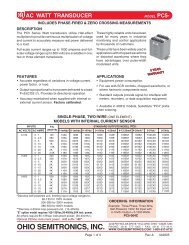FLEX CIRCUITS DESIGN GUIDE
Minco Flex Circuits Design Guide - BiS Sistem
Minco Flex Circuits Design Guide - BiS Sistem
- No tags were found...
Create successful ePaper yourself
Turn your PDF publications into a flip-book with our unique Google optimized e-Paper software.
Value Added Design Options<br />
Forming<br />
Flexible materials don’t guarantee that the circuit will function<br />
reliably when bent or flexed. There are many factors that contribute<br />
to the reliability of a printed flex circuit and all of these<br />
factors must be taken into account during the design process<br />
to ensure that the finished circuit will function reliably.<br />
When designing a flex circuit, the designer must factor in all of<br />
the parameters that will have an impact on the circuit’s ability<br />
to bend or flex in the specific application. These include, but are<br />
not limited to: whether the application is static or dynamic,<br />
bend radii, dielectric thicknesses and type, foil weight, copper<br />
plating, overall circuit thickness, number of layers, and number<br />
of flexures.<br />
The tighter a bend radius becomes, the higher the probability<br />
of failure during flexing. Keeping the overall thickness of the<br />
flex circuit in a bend area to its minimum will increase reliability.<br />
The ratio of bend radius to thickness is one indicator of whether<br />
the design is going to be reliable or have a high probability of<br />
failure. If the bend radius is at least ten times the thickness of<br />
the material, there is a good chance that the circuit will function<br />
reliably. If the calculated bend radius falls below ten to one,<br />
the design may be questionable. Formulas for calculating the<br />
minimum allowable bend radius for several circuit types can be<br />
found in IPC-2223.<br />
It is possible to design for much tighter bend radii, in a bendto-install<br />
application which retains the formed shape of the circuit.<br />
The circuit must be designed to withstand stretching along<br />
the outer bend and compression of materials on the inner<br />
bend. Stretching can tear covers or crack conductors while<br />
compression causes foil and cover wrinkling that can also lead<br />
to tears. These problems become more of a concern in applications<br />
that require the circuit to be bent beyond a 90-degree<br />
angle. As the bend angle increases beyond 90 degrees, the<br />
damaging effects of stretching and compressing increase dramatically.<br />
Any time that a reduced radii bend beyond 90<br />
degrees is incorporated into a circuit design, the circuit should<br />
be bent one time only. On bends over 90 degrees, it is also<br />
advisable to constrain the circuit in the formed condition to<br />
keep it from relaxing or being inadvertently reopened.<br />
The ideal circuit design would have no copper plating on the<br />
conductors in the forming or flexing area. Electrolytic copper<br />
has much lower ductility than that of rolled annealed copper,<br />
making it much more susceptible to fracturing when it is bent<br />
or flexed. Other types of plating, such as gold and/or nickel,<br />
should be avoided in the flexing area for the same reasons.<br />
Copper plating on the flexing conductors may be eliminated by<br />
using pads-only plating or designing with pads-only layers on<br />
the external surfaces.<br />
Minco can factory form some flex circuits with radii all the way<br />
down to a “crease”, dependent upon board design, to improve<br />
installation precision and repeatability within our customer’s<br />
assembly process.<br />
When designing a part for forming, it is important to avoid<br />
mechanical stressors in the bend zone. Stressors include pads,<br />
holes, components, and sharply angled conductors. These<br />
reflect the most common features problematic to forming.<br />
Forming imparts stress into circuits. Some designs will be better<br />
suited to this forming process than others. Minco encourages<br />
customers to discuss the intended usage of parts they want<br />
formed with our engineers to help determine suitability.<br />
Forms are likely to relax slightly over time. Tightly toleranced<br />
forms are not normally held by flex circuits. Minco recommends<br />
specifications to read “reference only” or to describe the<br />
parts as “capable of attaining ‘x’ dimensions” for both angular<br />
and linear aspects of forming.<br />
Formed parts are less capable of withstanding temperature<br />
variations than their un-formed counterparts. This is particularly<br />
true where the bend zones are exposed to solder reflow or high<br />
temperature sterilization procedures. To work around these limitations<br />
Minco can suggest optional designs or assembly<br />
processes. Please contact us to discuss your needs.<br />
Population<br />
Minco will also assemble hardware and electronic components<br />
onto your flex and rigid-flex circuits.<br />
Numerous connectors are available for flex termination, ranging<br />
from crimp connectors to nano-size SMT connectors or discrete<br />
pins.<br />
Heat-sinks, metal stiffeners, and plastic mounting frames may<br />
also be laminated, heat staked or glued to flex circuits.<br />
Flex-coil designs are an example of an embedded component<br />
supplied within flex, multilayer, and rigid-flex circuits.<br />
The most common electronic components are typically surface<br />
mounted to the flex circuit using automated pick-and-place<br />
equipment. Design considerations for populating flex circuits<br />
differ slightly from rigid boards. Simple flex circuits usually need<br />
to be stiffened for surface mount components. Our design engineers<br />
will make recommendations for necessary design factors<br />
to meet your needs.<br />
Between our in-house capabilities and our vendor network<br />
we’re able to offer our customers bare parts, palletized and<br />
unpopulated, partially populated or fully populated.<br />
22


